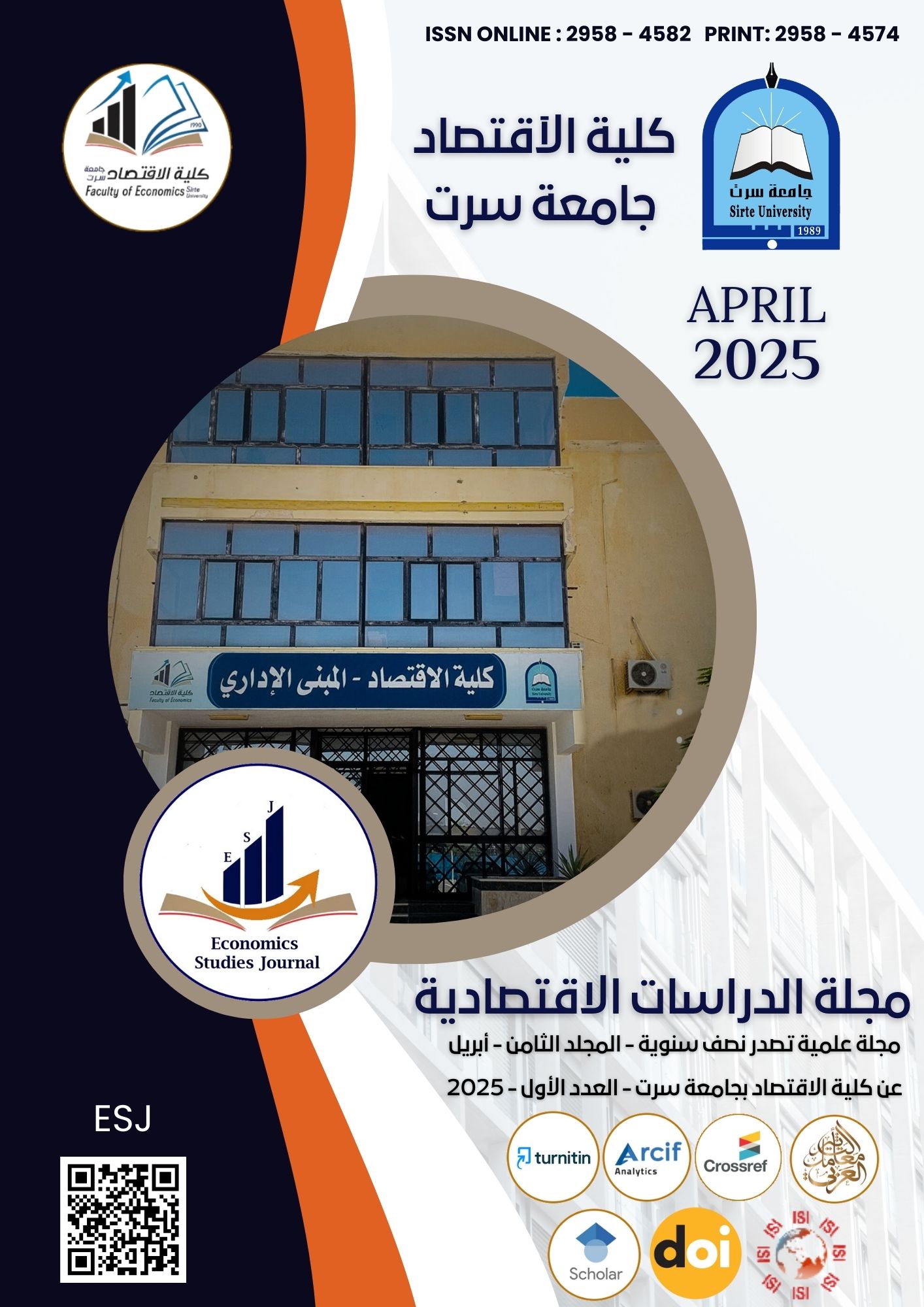Estimating the Impact of Banking Financial Depth Indicators on the Business Sector in Libya
DOI:
https://doi.org/10.37375/esj.v8i1.3261Keywords:
Financial Depth, Business Sector, Libyan Economy, NARDL ModelAbstract
This study aimed to demonstrate the relationship between financial depth and business sector indicators in the Libyan economy, especially after the financial developments that occurred in the Libyan banking sector, where annual data were analyzed during the period (1980-2022) using the Autoregressive Distributed Lag (NARDL) model. Results showed that the money supply indicator has a statistically significant impact, both positive and negative effects, on the business sector. Any increase in the money supply will result in an improvement in the business sector, while a decrease will also lead to an improvement in the business sector. This indicates that there is a non-linear relationship between the money supply and the growth of the business sector. At the same time, the results revealed a positive impact of the credit indicator on the growth of the business sector. An increase in the volume of credit will lead to growth in the business sector, while a decrease in the volume of credit had a statistically weak effect. The study also recommended working to create a suitable climate for the business sector by drawing up a policy for commercial banks in terms of (money supply - granting credit loans - determining the size of deposits) in a manner consistent with the conditions for improving the business sector, in addition to lifting banking and administrative restrictions.
References
المراجع :
المراجع العربية:
- أبوبكر بوسالم، رياض المزاودة (2016) آثار التحرير المالي على استقرار النظام المالي ومستوى التنمية المالية-الإشارة لحالة الجزائر. مجلة الدراسات المالية، المحاسبية والإدارية. العدد السادس، ديسمبر. 2016
- أنور النقيب(2021) العلاقة السببية بين العمق المالي والنمو الاقتصادي: حالة مصر، المجلة العلمية للدراسات والبحوث المالية والتجارية-العدد(2).
- العبيدي ، ليث سامي (2020) اتجاهات مؤشرات العمق المالي لعينة من الدول العربية( دراسة مقارنة)، بحث دبلوم العالي العلوم المالي والمصرفية، طلية الادارة والاقتصاد، جامعة الموصل ، العراق.
- خاطر، طارق (2013) اثر تدفقات الاستثمار الأجنبي المباشر والتعمق المالي عل النمو الاقتصادي بالجزار خلال الفترة 1990- 2013، مجلة الحقوق والعلوم الانسانية – دراسات اقتصادية 28 (2) ، جامعة زيان عاشور بالجلفة ، ص ص 164 – 177.
- صبحي حسون السعدي (2011) مؤشرات قياس العمق المالي-دراسة، تحليليه، في عينه، من الدول المختارة لفتره 19802010 -، المجلد 17، جامعه، بغداد، العراق صفحات220-222-223.
- صوفان، ذكريات يوسف، و الزعبي، بشير خليفة عبدالله. (2008) أثر تطور القطاع المالي على النمو الاقتصادي في الأردن للفترة 1978 - 2004 (رسالة دكتوراه غير منشورة). الجامعة الاردنية، عمان. مسترجع من .http://search.mandumah.com/Record/546559
- مريم روؤف فرح رزق ،(2016) دور الانفتاح المالي في تفسير الاختلاف في الإنتاجية الكلية للعوامل بين الدول بالتركيز على قناة الائتمان : دراسة مقارنة. رسالة ماجستير، جامعة القاهرة.
المراجع الاجنبية :
- Donald. Mathieson (1979),"Financial Reform and Capital Flows in a Developing Economy ", IMF Staff Papers, Volume 26, issue 3, September, 1979 (PP. 450-489).
- Alrabadi, D. W. H., & Kharabsheh, B. A. (2019). Financial Deepening and Economic Growth: The Case of Jordan. Journal of Accounting and Finance, 16(6). Retrieved from https://articlegateway.com/index.php/JAF/article/view/1067.
- Kenza,M , Nacer.G & Eddine.S (2016), The Effect of the Financial Sector Development on Growth: The Case of the MENA Countries, Arab Economic and Business Journal, Volume 11, Issue 1, June 2016, Pages 72-85.
- Levine, A. & King.(1993) Financial Development and Economic Growth: Views and Agenda, Journal of Economic Literature.vol.2.PP 231-276.
- Medjahed, K. & Gherbi, N.S.E. (2016). The Effect of the financial sector development on growth: The case of the MENA countries. Arab Economic and Business Journal, 11, 72–85.
- Ozsahin, S., & Uysal, D, (2017). Financial Deepening and Economic Development in MENA Countries: Empirical Evidence from the Advanced Panel Method, and International Journal of Economics and Finance, Canadian Center of Science Education, vol. 9(4). PP 152-162.
- Pesaran, M. H., Shin, Y. & Smith, R. J., (2001), Bound Testing Approaches to the Analysis of Level Relationship, Journal of Applied Econometrics, Vol. 16, PP 289-326.
- Schumpeter, J. (1911) the Theory of Economic Development”. Oxford: Oxford University.
- Shin, Y., Yu, B., & Greenwood-Nimmo, M. (2014). Modelling asymmetric cointegration and dynamic multipliers in a nonlinear ARDL framework. In R. C.
- Vicente Galbis (1977),"Financial intermediation and economic growth in less-developed countries: A theoretical approach ", The Journal of Development Studies, Special Issue: Finance in Developing Countries, PP. 52-88.





























